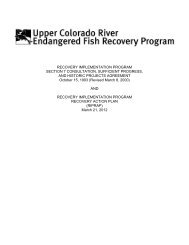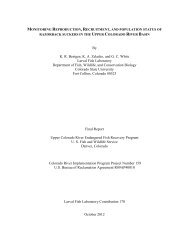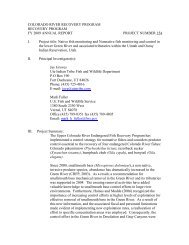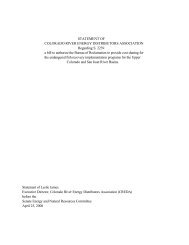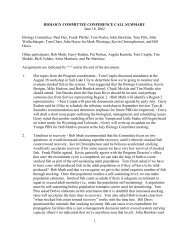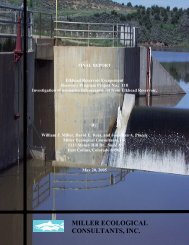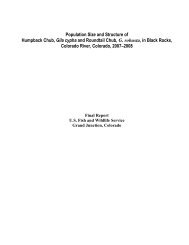Final Programmatic Biological Opinion for Bureau of Reclamation's
Final Programmatic Biological Opinion for Bureau of Reclamation's
Final Programmatic Biological Opinion for Bureau of Reclamation's
You also want an ePaper? Increase the reach of your titles
YUMPU automatically turns print PDFs into web optimized ePapers that Google loves.
found downstream <strong>of</strong> Grand Junction (McAda and Kaeding 1991, Osmundson and Burnham1998). Aggregations <strong>of</strong> ripe adults have been found near Clifton and Grand Junction, Coloradoand near the Colorado-Utah state line (Osmundson and Kaeding 1989, McAda and Kaeding 1991,USFWS unpublished data). Suitable spawning habitat (defined below) in the Colorado River nearCataract Canyon, Pr<strong>of</strong>essor Valley, and upstream from the Dolores River confluence indicatespawning may occur in or near these areas as well (Archer et al. 1985; Valdez 1990).Known spawning sites in the Yampa River are characterized by riffles or shallow runs withwell-washed coarse substrate (cobble containing relatively deep interstitial voids (<strong>for</strong> eggdeposition) in association with deep pools or areas <strong>of</strong> slow laminar flow used as staging areas byadults (Lamarra et al. 1985, Tyus 1990). Recent investigations at a spawning site in the San JuanRiver by Bliesner and Lamarra (1995) and at one in the upper Colorado River (USFWSunpublished data) indicate a similar association <strong>of</strong> habitats. The most unique feature at the sitesactually used <strong>for</strong> spawning, in comparison with otherwise similar sites nearby, is the degree <strong>of</strong>looseness <strong>of</strong> the cobble substrate and the depth to which the rocks are devoid <strong>of</strong> fine sediments;this appears consistent at the sites in all three rivers (Lamarra et al. 1985, Bliesner and Lamarra1995).Data indicates that clean cobble substrates that provide interstitial spaces <strong>for</strong> eggs are necessary<strong>for</strong> spawning and egg incubation (Tyus and Karp 1989). Several studies on the cobble cleaningprocess have been conducted at a known spawning location in Yampa Canyon. O'Brien (1984)studied the hydraulic and sediment transport dynamics <strong>of</strong> the cobble bar within the Yampa Riverspawning site and duplicated some <strong>of</strong> its characteristics in a laboratory flume study. O'Brien(1984) concluded that incipient motion <strong>of</strong> the cobble bed is required to clean cobbles <strong>for</strong>spawning and estimated that this takes discharges <strong>of</strong> about 21,500 cfs. However, Harvey et al.(1993) concluded that since flows required <strong>for</strong> incipient motion <strong>of</strong> bed material are rare (20 yearreturn period event) and spawning occurs annually, another process must be cleaning the cobbles.Their study found that in Yampa Canyon recessional flows routinely dissect gravel bars andthereby produce tertiary bars <strong>of</strong> clean cobble at the base <strong>of</strong> the riffles. These tertiary bars are usedby Colorado pikeminnow <strong>for</strong> spawning. The importance <strong>of</strong> high magnitude, low frequencydischarges is in <strong>for</strong>ming and maintaining the midchannel bars. Dissection <strong>of</strong> bars withoutredeposition by high magnitude flows would lead to conditions where spawning habitat is nolonger available (Harvey et al. 1993).It is unknown whether tertiary bars similar to those used <strong>for</strong> Colorado pikeminnow spawning inYampa Canyon are available in the 15-Mile Reach <strong>of</strong> the Colorado River. There, significantmotion <strong>of</strong> bed material occurs at near bankfull discharge <strong>of</strong> 22,000 cfs (Van Steeter 1996). Theseflows occur on average once in 4 years. Van Steeter (1996) concluded that flows <strong>of</strong> thismagnitude are important because they generally remove fine sediment from the gravel matrixwhich maintains the invertebrate community and cleans spawning substrate.Although the location <strong>of</strong> spawning areas in the Colorado River is not as defined as in the YampaRiver, the annual presence <strong>of</strong> larvae and young-<strong>of</strong>-the-year downstream <strong>of</strong> the Walker Wildlife23



